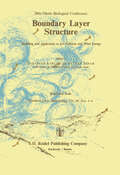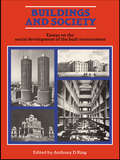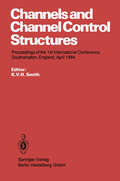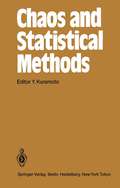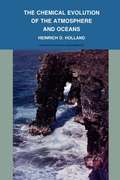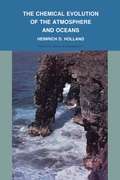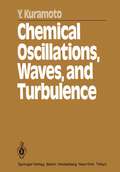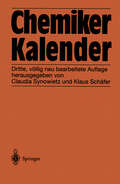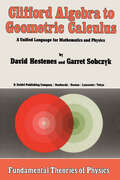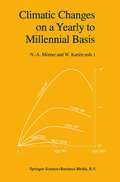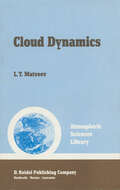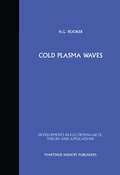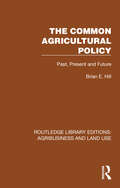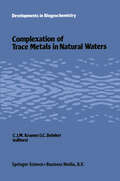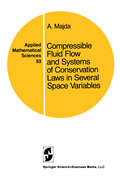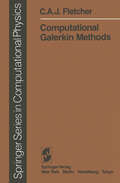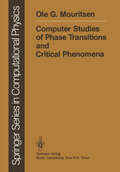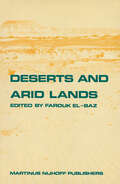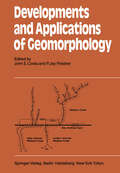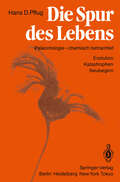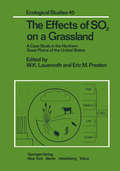- Table View
- List View
Boundary Layer Structure: Modeling and Application to Air Pollution and Wind Energy
by Hadassah Kaplan Nathan DinarIn this volume, we present the lectures given during the 1984 OHOLO Conference, held in Zichron Yaacov, Israel. The Conference was organized by the Israel Institute for Biological Research, Department of Mathematics, which is involved in Environmental Risk Evaluation, and in Projects Estimating the Potential of Wind Energy. The lectures cover a broad spectrum of mathematical models, ranging from those that deal with the solution of atmospheric conservation equations, and to those models that yield empirical estimates based on real time measure ments and thus are unique to the locale where measured. The goal of the Conference was to allow scientists from various countries to meet and discuss topics of mutual interest, including the following: 1. Structure of the boundary layer - primarily models dealing in the understanding of the various processes of atmospheric energy transfer, and their influence on the size and composition of the boundary 1 ayer. 2. Advanced mathematical techniques for describing flow and diffusion - lectures on approximations and techniques for solving the diffu sion and transport equations. 3. Flow over complex terrain - research into various aspects of the problem - mathematical models, physical models, experimental results. 4. Models of pollution transport and deposition.
Buildings and Society: Essays on the Social Development of the Built Environment
by Anthony D. KingFirst Published in 1984. Routledge is an imprint of Taylor & Francis, an informa company.
Buildings and Society: Essays on the Social Development of the Built Environment
by Anthony D. KingFirst Published in 1984. Routledge is an imprint of Taylor & Francis, an informa company.
Channels and Channel Control Structures: Proceedings of the 1st International Conference on Hydraulic Design in Water Resources Engineering: Channels and Channel Control Structures, University of Southampton, April 1984
by K. V. H. SmithThe development of water resources has proceeded at an amazing speed around the world in the last few decades. The hydraulic engineer has played his part: in constructing much larger artificial channels than ever before, larger and more sophisticated control structures, and systems of irrigation, drainage and water supply channels in which the flow by its nature is complex and unsteady requiring computer-based techniques at both the design and operation stage. It seemed appropriate to look briefly at some of the developments in hydraulic design resulting from this situation. Hence the idea of the Conference was formed. The Proceedings of the Conference show that hydraulic engineers have been able to acquire a very substantial base of design capability from the experience of the period referred to. The most outstanding development to have occurred is in the combination of physical and mathematical modelling, which in hydraulic engineering has followed a parallel path to that in other branches of engineering science. The Proceedings of this Conference will give to the reader an awareness of the current state of hydraulic design in open channel flow and open channel control structures. K.V.H. Smith Editor 1. CONTROL AND DIVERSION STRUCTURES 1-3 FACTORS AFFECTING BRINK DEPTH IN RECTANGULAR OVERFALLS G.C. Christodoulou, G.C. Noutsopoulos and S.A. Andreou Dept. of Civil Engineering, National Technical Univ. of Athens, Greece.
Chaos and Statistical Methods: Proceedings of the Sixth Kyoto Summer Institute, Kyoto, Japan September 12–15, 1983 (Springer Series in Synergetics #24)
by Y. KuramotoThe Chemical Evolution of the Atmosphere and Oceans
by Heinrich D. HollandIn this first full-scale attempt to reconstruct the chemical evolution of the Earth's atmosphere and oceans, Heinrich Holland assembles data from a wide spectrum of fields to trace the history of the ocean-atmosphere system. A pioneer in an increasingly important area of scholarship, he presents a comprehensive treatment of knowledge on this subject, provides an extensive bibliography, and outlines problems and approaches for further research. The first four chapters deal with the turbulent first half billion years of Earth history. The next four chapters, devoted largely to the Earth from 3.9 to 0.6 b.y.b.p., demonstrate that changes in the atmosphere and oceans during this period were not dramatic. The last chapter of the book deals with the Phanerozoic Eon; although the isotopic composition of sulfur and strontium in seawater varied greatly during this period of Earth history, the chemical composition of seawater did not.
The Chemical Evolution of the Atmosphere and Oceans (Princeton Series in Geochemistry #2)
by Heinrich D. HollandIn this first full-scale attempt to reconstruct the chemical evolution of the Earth's atmosphere and oceans, Heinrich Holland assembles data from a wide spectrum of fields to trace the history of the ocean-atmosphere system. A pioneer in an increasingly important area of scholarship, he presents a comprehensive treatment of knowledge on this subject, provides an extensive bibliography, and outlines problems and approaches for further research.The first four chapters deal with the turbulent first half billion years of Earth history. The next four chapters, devoted largely to the Earth from 3.9 to 0.6 b.y.b.p., demonstrate that changes in the atmosphere and oceans during this period were not dramatic. The last chapter of the book deals with the Phanerozoic Eon; although the isotopic composition of sulfur and strontium in seawater varied greatly during this period of Earth history, the chemical composition of seawater did not.
Chemical Oscillations, Waves, and Turbulence (Springer Series in Synergetics #19)
by Y. KuramotoTbis book is intended to provide a few asymptotic methods which can be applied to the dynamics of self-oscillating fields of the reaction-diffusion type and of some related systems. Such systems, forming cooperative fields of a large num of interacting similar subunits, are considered as typical synergetic systems. ber Because each local subunit itself represents an active dynamical system function ing only in far-from-equilibrium situations, the entire system is capable of showing a variety of curious pattern formations and turbulencelike behaviors quite unfamiliar in thermodynamic cooperative fields. I personally believe that the nonlinear dynamics, deterministic or statistical, of fields composed of similar active (Le., non-equilibrium) elements will form an extremely attractive branch of physics in the near future. For the study of non-equilibrium cooperative systems, some theoretical guid ing principle would be highly desirable. In this connection, this book pushes for ward a particular physical viewpoint based on the slaving principle. The dis covery of tbis principle in non-equilibrium phase transitions, especially in lasers, was due to Hermann Haken. The great utility of this concept will again be dem onstrated in tbis book for the fields of coupled nonlinear oscillators.
Clifford Algebra to Geometric Calculus: A Unified Language for Mathematics and Physics (Fundamental Theories of Physics #5)
by D. Hestenes Garret SobczykMatrix algebra has been called "the arithmetic of higher mathematics" [Be]. We think the basis for a better arithmetic has long been available, but its versatility has hardly been appreciated, and it has not yet been integrated into the mainstream of mathematics. We refer to the system commonly called 'Clifford Algebra', though we prefer the name 'Geometric Algebm' suggested by Clifford himself. Many distinct algebraic systems have been adapted or developed to express geometric relations and describe geometric structures. Especially notable are those algebras which have been used for this purpose in physics, in particular, the system of complex numbers, the quatemions, matrix algebra, vector, tensor and spinor algebras and the algebra of differential forms. Each of these geometric algebras has some significant advantage over the others in certain applications, so no one of them provides an adequate algebraic structure for all purposes of geometry and physics. At the same time, the algebras overlap considerably, so they provide several different mathematical representations for individual geometrical or physical ideas.
Climatic Changes on a Yearly to Millennial Basis: Geological, Historical and Instrumental Records
by N. A. Mörner W. KarlénNils-Axel Marner &Wibjarn Karlen Organizers of the Stockholm Symposium in 1983 Stockholm University, Sweden This book is the Proceedings of the SECOND NORDIC SYMPOSIUM ON CLIMATIC CHANGES AND RELATED PROBLEMS held in Stockholm, Sweden, May 16-20, 1983 (Frydendahl et al., 1983; Marner, 1983). This was "an international interdisciplinary symposium with special refe rence to Nordic records and their relation to global climatic changes". The first NORDIC SYMPOSIUM ON CLIMATIC CHANGES AND RELATED PROBLEMS was held in Copenhagen in 1978 ( Frydendahl, 1978) and had a very broad scientific program. The SECOND NORDIC SYMPOSIUM was specifically directed to certain problems, time ranges and sources of information, as discussed below. Scandinavia is a classical area for the study of climatic fluctuations during the last 20,000 years . A major part of the basic data for the international theories and synthesis originate from Scandinavian data. This applies, for example, to: (1) The drastic climatic fluctuations in connection with the re cession of the land-ice giving rise to the alternation of inter stadials (warm periods with rapid ice recession) and stadials (cold periods with readvances or retardations in the ice recession). (2) The climatic changes during the Holocene with its well-known sub-division according to the Blytt-Sernander system (nowadays being used far outside the boreal region for which it was origi nally defined). (3) The Holocene climatic optimum and the subsequent climatic de terioration at around 2500 BP (well-established already at the beginning of this century).
Cloud Dynamics (Atmospheric and Oceanographic Sciences Library #2)
by L.T. MatveevDuring recent decades a new field of study in atmospheric science has made its appearance - the dynamics of clouds. As the name implies, the subject matter of cloud dynamics includes the causes of cloud formation and the temporal development of clouds. At first, effort was concentrated mainly on devising models of the structure and development of convective clouds, and thus there exists considerable literature on this [9, 69, 88, 330, 411]. Although convective clouds are of great significance (thunder storm formation and very intense turbulence are associated with these clouds), they are observed much less frequently than other cloud types. For instance, the frequency of occurrence of strati form (frontal) clouds and wave clouds over the U.S.S.R. and Western Europe is more than 90% [2-4]. During the last 20 or 30 years there has been considerable success in studying the dynamics of stratiform clouds. Fundamental laws (equations) describing the formation, development, and dis sipation of these clouds (and also of fog) have been formulated, and also laws describing the formation of humidity and temperature fields in a turbulent medium. Hydrodynamic models of clouds and fog constructed on the basis of these equations have made it pos sible to formulate the fundamental regularities in the formation and evolution of large-scale cloud fields, and also to ascertain the structural features of clouds of various kinds. These topics are covered in Chapters 1-4 of this monograph.
Cold Plasma Waves (Developments in Electromagnetic Theory and Applications #2)
by H.G. BookerThe book aims to present current knowledge concerning the propagation of electro magnetic waves in a homogeneous magnetoplasma for which temperature effects are unimportant. It places roughly equal emphasis on the radio and the . hydromagnetic parts of the electromagnetic spectrum. The dispersion properties of a magnetoplasma are treated as a function both of wave frequency (assumed real) and of ionization density. However, there is little discussion of propagation in a stratified medium, for of collisions is included only which reference may be made to Budden [1] . The effect in so far as this can be done with simplicity. The book describes how pulses are radiated from both small and large antennas embedded in a homogeneous magneto plasma. The power density radiated from a type of dipole antenna is studied as a function of direction of radiation in all bands of wave frequency. Input reactance is not treated, but the dependence of radiation resistance on wave frequency is described for the entire electromagnetic spectrum. Also described is the relation between beaming and guidance for Alfven waves.
The Common Agricultural Policy: Past, Present and Future (Routledge Library Editions: Agribusiness and Land Use #14)
by Brian E. HillOriginally published in 1984, this book provides an introduction to the history of agriculture in Western Europe, states the case for government intervention and analyses the operation of the Common Agricultural Policy (CAP) during the late 20th Century. It concludes that the costs of the policy fell heavily on the poorer consumers, food prices were artificially high and surpluses sold at a loss on the world markets. In the light of Britain’s departure from the EU and the EU CAP this book, which also examined the prospects for the future has an enduring relevance.
The Common Agricultural Policy: Past, Present and Future (Routledge Library Editions: Agribusiness and Land Use #14)
by Brian E. HillOriginally published in 1984, this book provides an introduction to the history of agriculture in Western Europe, states the case for government intervention and analyses the operation of the Common Agricultural Policy (CAP) during the late 20th Century. It concludes that the costs of the policy fell heavily on the poorer consumers, food prices were artificially high and surpluses sold at a loss on the world markets. In the light of Britain’s departure from the EU and the EU CAP this book, which also examined the prospects for the future has an enduring relevance.
Complexation of trace metals in natural waters: Proceedings of the International Symposium, May 2–6 1983, Texel, The Netherlands (Developments in Biogeochemistry #1)
by C. J. Kramer J. C. DuinkerIt is presently well recognized that total concentrations of trace elements in any environmental compartment supply insufficient information to understand important phenomena. The distinction and separate analysis of specific chemical species are essential for understanding cycles in the aquatic environment, involving identification and quantification of sources, transport pathways, distributions and sinks, or, in the area of interactions between trace elements and organisms to understand uptake, distribution, excretion mechanisms and effects. In the past, various ways have been developed to determine the nature and extent of complexation of trace elements in natural systems. Approaches have been followed along very different lines. These have not always been fully appreciated by specialists working in even related fields of complexation research. The first International Symposium on the Complexation of Trace metals in Natural Waters was held at the Netherlands Institute for Sea Research (NIOZ, Texel, the Netherlands from 2-6 May 1983. The scientific programme was planned by the chief organizers Drs. C.J.M. Kramer and J.C. Duinker (NIOZ) together with Prof. Dr. H.W. Nurnberg (Kernforschungsanlage, Julich, Federal Republic of Germany) and Dr. M. Branica (Rudjer Boskovic Institute, Zagreb, Yugoslavia).
Compressible Fluid Flow and Systems of Conservation Laws in Several Space Variables (Applied Mathematical Sciences #53)
by A. MajdaConservation laws arise from the modeling of physical processes through the following three steps: 1) The appropriate physical balance laws are derived for m-phy- t cal quantities, ul""'~ with u = (ul' ... ,u ) and u(x,t) defined m for x = (xl""'~) E RN (N = 1,2, or 3), t > 0 and with the values m u(x,t) lying in an open subset, G, of R , the state space. The state space G arises because physical quantities such as the density or total energy should always be positive; thus the values of u are often con strained to an open set G. 2) The flux functions appearing in these balance laws are idealized through prescribed nonlinear functions, F.(u), mapping G into J j = 1, ..• ,N while source terms are defined by S(u,x,t) with S a given smooth function of these arguments with values in Rm. In parti- lar, the detailed microscopic effects of diffusion and dissipation are ignored. 3) A generalized version of the principle of virtual work is applied (see Antman [1]). The formal result of applying the three steps (1)-(3) is that the m physical quantities u define a weak solution of an m x m system of conservation laws, o I + N(Wt'u + r W ·F.(u) + W·S(u,x,t))dxdt (1.1) R xR j=l Xj J for all W E C~(RN x R+), W(x,t) E Rm.
Computational Galerkin Methods (Scientific Computation)
by C. A. FletcherIn the wake of the computer revolution, a large number of apparently uncon nected computational techniques have emerged. Also, particular methods have assumed prominent positions in certain areas of application. Finite element methods, for example, are used almost exclusively for solving structural problems; spectral methods are becoming the preferred approach to global atmospheric modelling and weather prediction; and the use of finite difference methods is nearly universal in predicting the flow around aircraft wings and fuselages. These apparently unrelated techniques are firmly entrenched in computer codes used every day by practicing scientists and engineers. Many of these scientists and engineers have been drawn into the computational area without the benefit offormal computational training. Often the formal computational training we do provide reinforces the arbitrary divisions between the various computational methods available. One of the purposes of this monograph is to show that many computational techniques are, indeed, closely related. The Galerkin formulation, which is being used in many subject areas, provides the connection. Within the Galerkin frame-work we can generate finite element, finite difference, and spectral methods.
Computer Studies of Phase Transitions and Critical Phenomena (Scientific Computation)
by Ole G. University of Southern DenmarkDer Einfluß von industriellen Großunternehmen auf die raum- und siedlungsstrukturelle Entwicklung im Verdichtungsraum Rhein-Ruhr (Forschungsberichte des Landes Nordrhein-Westfalen #3176)
by Gerd RojahnDeserts and arid lands (Remote Sensing of Earth Resources and Environment #1)
by FaroukEl-BazRemote sensing is the study of a region from a distance, particularly from an airplane or a spacecraft. It is a tool that can be used in conjunction with other methods of research and investigation. This tool is especially applicable to the study of the deserts and arid lands of the Earth because of their immense size and their inaccessibility to detailed study by conventional means. In this book examples are given of the utility of aerial photographs and space images in the study of semi-arid, arid, and hyper-arid terrains. Emphasis is placed on the physical features and terrain types using examples from around the world. The authors I have called upon to prepare each chapter are renowned specialists whose contributions have received international recognition. To the general reader, this book is a review of our knowledge of the relatively dry parts of the Earth, their classification and varied features, their evolution in space and time, and their development potentials. To the specialist, it is a detailed account of the deserts and arid lands, not only in North America, but also their relatively unknown counterparts in North Africa, Australia, China, India, and Arabia.
Developments and Applications of Geomorphology
by John E. Costa and P. Jay FleisherThe last decade has seen a remarkable increase in the application of geomorphology for numerous projects and investigations. Geomor phology is now viewed as an indispensable partner of engineering and geology in the world of applied science. For a discipline with few independent theories of its own, geomorphology has become a cosmopolitan science, drawing on many topics from allied sciences. To compile a list of successful and viable applications and contribu tions would be an arduous chore, if not an impossible task. Instead we have compiled a set of invited papers that represent some of the practical developments and uses of geomorphology over the past de cade. Such a compilation of papers will reflect our own back grounds, biases, associations, and personal and professional expe riences. We make no apologies for the topics omitted, but recognize that this volume could be prohibitively large if all the subdivisions of geomorphology were equally and fully covered. Our goal in assembling the papers for this volume was to empha size the concepts, principles, and applications of geomorphology. While techniques, procedures and practical applications are stressed, the reason for each investigation is as important as the method em ployed. This book, therefore, represents the methods used and reasons for applying geomorphology. Where case studies are used, they serve as examples that can be applied in related situations, similar settings and other locations. The authors have successfully addressed this goal in a broad selection of chapter topics.
Die Spur des Lebens: Paläontologie — chemisch betrachtet Evolution Katastrophen Neubeginn
by H.D. PflugThe Effects of SO2 on a Grassland: A Case Study in the Northern Great Plains of the United States (Ecological Studies #45)
by William Lauenroth E. M. Preston William 1727-1791 WilliamsWhen Springer-Verlag undertook publication of this volume, two opportunities arose. The first was to bring together the significant findings ofthe interacting parts of a large field experiment on a whole ecosystem. Scientific specialists and the public are rightly concerned with large-scale impacts of human activity on landscapes and with the challenge of predicting subtle, long-range repercussions of air pollution. A fundamental issue is whether ecological systems like grasslands, which have evolved for several million years under stressful conditions such as variable climate and overgrazing, are more robust than other systems in tolerating new atmospheric impacts of pollution and toxicity. At what level, and when, will an extra geochemical input, like sulfur (Chapter 4), an essential nutrient for proteins and life processes, become an overload on these systems? Some grasses and grassland ecosystems seem fairly adaptable to burdens in addition to those of weather change and tissue removal. How can experts learn to project the future of the heartland of America and other grasslands of the world on the basis of only a few years of observation and control? The second opportunity addresses a broader aspect of the project that is of interest to many readers who are not concerned with details of physiology or food chains, or the overall productivity and variations of a single plant-animal-soil community.
